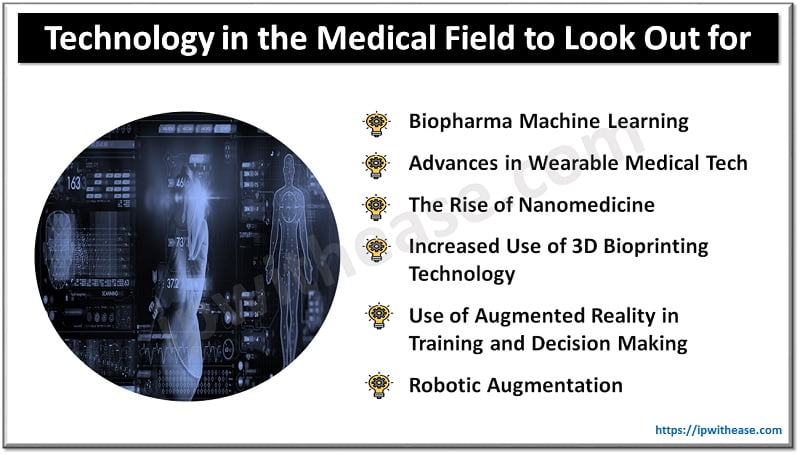Table of Contents
Tech is advancing at a faster pace than ever before, and nowhere is this more notable than in the medical field. The last year has seen many remarkable advances, from leaps forward in wearable medical tech to the development of optical fiber imaging methods that have advanced the study of Alzheimer’s Disease.
Next year, more exciting new advances in medical tech are set to change the landscape of patient care still further and include robotic augmentation and 3D bioprinting. We take a closer look below.

Biopharma Machine Learning
Although it sounds straight out of a sci-fi movie, biopharma machine learning is already on the horizon. The pharma industry is expected to make increasing use of AI to identify and develop new drugs. AI-enhanced lab experiments have already discovered some potential new formulas to be used concerning several rare diseases, and projects like these are expected to ramp up significantly in 2024.
It’s an approach that allows scientists to reduce costly on-site experiments – many of the necessary trials can be conducted virtually, which speeds up the process exponentially, too.
Advances in Wearable Medical Tech
These advances have been especially beneficial to seniors wishing to stay in their own homes but who may be experiencing issues relating to frailty or other health conditions. Highly wearable tech – replacing the old, clunky panic buttons that connected via landline – is now increasing the quality of life and peace of mind of millions of older adults.
Next year, this trend for ever-more sophisticated wearable tech will continue. Discreet, lightweight equipment such as the Unaliwear Kanega watch is set to provide holistic solutions that go way beyond the provision of a panic button. This particular bit of kit offers 24/7 monitoring, medication reminders, fall detection, and GPS tracking.
Wearable tech is on the market that monitors vitals such as blood pressure and blood saturation levels, meaning that more people who would have been kept in hospital simply for routine monitoring can now be discharged to the comfort of their homes to continue their recovery.
The Rise of Nanomedicine
Nanotech involves the use of super super tiny – as in microscopic – materials and objects, and the last couple of years have seen its rise in the medical field. At the end of 2021, the scientific community made the awe-dropping announcement that it had succeeded in creating tiny organic robots, called xenobots, that had the capacity to self-duplicate.
Next year it’s predicted that Nanomedicine will continue to develop, with some potentially hugely significant consequences. In the near future, it’s hoped that nanobots could be deployed as hunters for cancer or virus cells in the body once they’re injected into the bloodstream. The new tech is also predicted to be vital in the fight against many genetic, auto-immune, and oncologic diseases on a cellular level.
Increased Use of 3D Bioprinting Technology
By 2027, it’s estimated that the value of 3D printing opportunities will exceed $6 billion in the medical world. As well as becoming more reliable, it is thought that the tech will also use new materials and more sophisticated methods.
This will result in greater customization of prostheses for knees, hips, skulls, spine, etc., and the production of fully-functional mechanical limbs that are lightweight and have improved integration with the other bones in the body. It’s also hoped that advances in this area will lead to more options for printing live-saving implants for neurological and cardiovascular patients.
Use of Augmented Reality in Training and Decision Making
The rise of augmented reality will welcome in a new world of medical training, with students able to practice their skills in a highly realistic virtual setting.
In the ‘real’ world, this tech will provide additional layers of detail to doctors or surgeons, who can automatically access the information they require without needing to visit the patient in person. This could be revolutionary in the delivery of healthcare. It’s predicted that surgeons will soon be able to carry out procedures remotely, using advanced tech that allows them to ‘feel’ sensations and make minute adjustments as the operation progresses.
Robotic Augmentation
Robots will increasingly work alongside their human counterparts in hospitals and other healthcare settings to create a smoother workflow and ensure higher levels of patient care. As well as hygiene and remote diagnostic capabilities, robots will likely also be used to promote better the welfare of medical staff – not least by relieving the pressures caused by an overburdened healthcare system.
Looking Beyond 2024
And what are the advances we can expect beyond 2024? Well, genetic screening and genomic testing are likely to be used as standard to not only identify patients at risk of developing a condition but to work in tandem with wearable tech to provide custom treatments to keep patients well long-term.
Big data will also change everything, with macro and micro information pouring in on health trends from a near-infinite number of sources and helping healthcare providers to anticipate and act on the needs identified. Ultimately, better patient outcomes are the overall goal with all the new tech being developed and deployed – and the future in this regard is looking very bright indeed.
Continue Reading:
Maintenance Management For Healthcare Facilities using CMMS Software
Cybersecurity in Healthcare Sector
ABOUT THE AUTHOR
IPwithease is aimed at sharing knowledge across varied domains like Network, Security, Virtualization, Software, Wireless, etc.



